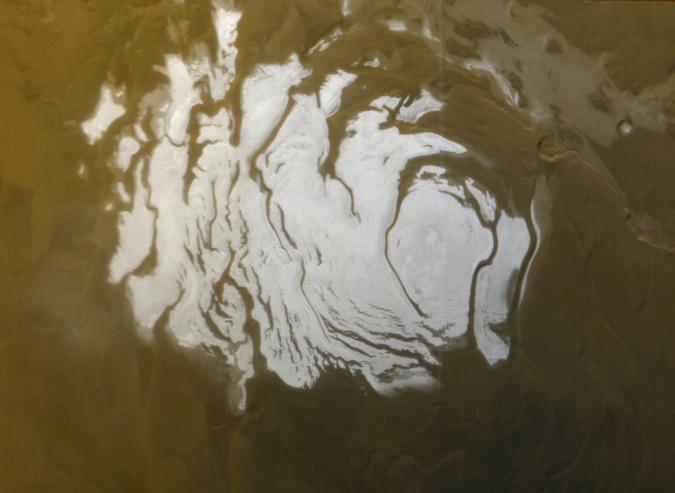Monday, May 16, 2005
Cracking The Case of The Missing Ice Cap
American scientists say they have solved the mystery of a missing Martian icecap.

Mars, like Earth, has two icy polar caps. While the north pole appears to a fairly ordinary specimen, the south pole is a "strange animal," said Jeffrey Barnes, a professor of atmospheric sciences at Oregon State University. The southern ice cap is tiny compared to its nothern brother, about ten times smaller. It is made of carbon dioxide ice, the same stuff that street corner ice cream vendors use to cool their popsicles. That's normal since Martian atmosphere is rich in carbon dioxide.
What's unusual is that this dry ice is sequestered away from the planet's south pole. The pole itself is in the "cryptic region" which doesn't appear to have any ice at all. "No one has been able to figure out why there is this peculiar distribution of ice deposits," said Barnes.
Until now. Analyzing images and temperature measurements from the Mars Global Surveyor probe and plugging the data into climate models, Barnes and his colleagues from NASA figured out that the south pole is covered by a three-fee deep lid of crystal clear ice that's completely transparent. "We basically think the cryptic region is a sheet on incredibly clear ice," said Barnes. "The reason for the low reflectivity is that the ground beneath it shows right through it."
The scientists think that unlike visible ice caps, which on Mars as well as on Earth accumulate during snowfall, the clear ice forms when the Martian carbon dioxide atmosphere reaches brutal -193 F, starts behaving like freezing molasses, and "condenses right on the ground and forms slabs of ice."

Mars, like Earth, has two icy polar caps. While the north pole appears to a fairly ordinary specimen, the south pole is a "strange animal," said Jeffrey Barnes, a professor of atmospheric sciences at Oregon State University. The southern ice cap is tiny compared to its nothern brother, about ten times smaller. It is made of carbon dioxide ice, the same stuff that street corner ice cream vendors use to cool their popsicles. That's normal since Martian atmosphere is rich in carbon dioxide.
What's unusual is that this dry ice is sequestered away from the planet's south pole. The pole itself is in the "cryptic region" which doesn't appear to have any ice at all. "No one has been able to figure out why there is this peculiar distribution of ice deposits," said Barnes.
Until now. Analyzing images and temperature measurements from the Mars Global Surveyor probe and plugging the data into climate models, Barnes and his colleagues from NASA figured out that the south pole is covered by a three-fee deep lid of crystal clear ice that's completely transparent. "We basically think the cryptic region is a sheet on incredibly clear ice," said Barnes. "The reason for the low reflectivity is that the ground beneath it shows right through it."
The scientists think that unlike visible ice caps, which on Mars as well as on Earth accumulate during snowfall, the clear ice forms when the Martian carbon dioxide atmosphere reaches brutal -193 F, starts behaving like freezing molasses, and "condenses right on the ground and forms slabs of ice."